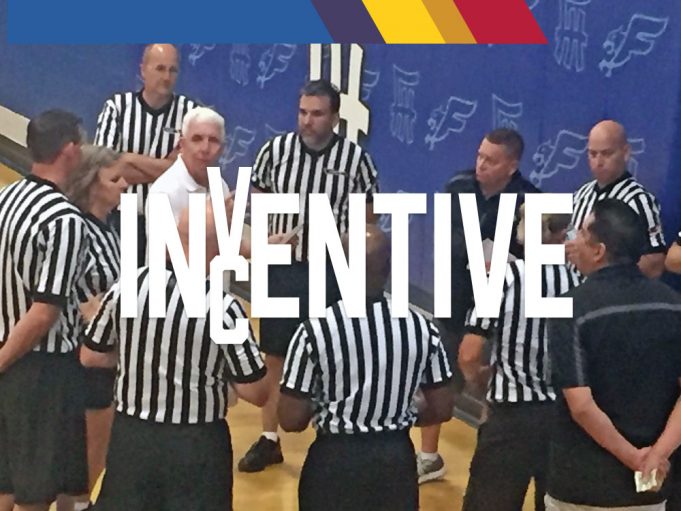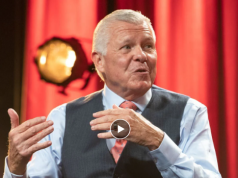L
ate last winter the math became clear for Arizona Interscholastic Association (AIA) State Commissioner of Officials Brian Gessner.
“We’re not doing a very good job with retention (of officials),” he said.
That point was made abundantly clear in January 2020, when Gessner and the AIA sent an email to coaches and school administrators across Arizona to let them know that they needed to move some of their basketball games from the popular Tuesday night spots to Mondays, Wednesdays and Thursdays to try and avoid gaps in officiating coverage.
In short, he and his staff needed to find a way to bring more and younger officials into the fold, so they started brainstorming and enlisting the support of their fellow officials.
The task is critical, Gessner noted. Arizona’s population has grown by more than 600,000 people from 2010-19 (6.67 million to 7.28 million) but the number of officials to work games has remained somewhat static (in round numbers Gessner estimated about 3,000 total officials for all sports).
With the population still growing, there are more games to be covered but not enough officials to cover the growing number of assignments. (The AIA is one of the few state associations that makes all regular and postseason game assignments for its officials.)
“Arizona is a growth state, it’s as simple as that,” Gessner said. “We are actually flat when it comes to officials. We’re not losing many but we’re really not growing our number either.
“Compared to some other states we’re in a good situation, but we’re simply not keeping up with the population.”
Gessner realized having enough officials to meet the demand would be one of the biggest challenges of his still young administrative career. He came into his job in January 2018, having spent 30 years in officiating. He was named the 2009 AIA Boys Basketball Official of the Year.
He used all the insights he gathered from his long career, which included travel to New Mexico and Colorado to work games, as a basis for the solution.
“I got to know some other processes,” he said.
In the end, Gessner enlisted the help of fellow AIA staffers Jeanie Kosower and Tyler Cerimeli to create an incentive program that the AIA started up in July 2020, while Arizona and the rest of the country were still deep in the throes of the COVID-19 pandemic.
“(The timing) sucks,” Gessner said frankly. “We picked the worst time to start it, but we’re making the best of it.”
The basics of the program are pretty simple. Any active AIA official who recruits a new official and gets them to return will receive credits that can be applied to their sports registration fees.
Key parts of the system are that when filling out their online registration forms, the new recruit must list the official who spoke to him or her about joining.
When the new official returns for three subsequent years, the recruiting official will receive a credit each year that will be applied to his or her sports registration fees ($40 value per credit per recruit). The credits are non-transferable, non-refundable and have no monetary value. The recruiting official will be able to earn three credits per new recruit.
And this is the part that’s key in Gessner’s mind: The number of credits that a veteran official can earn in total is only limited by the number of new officials they recruit.
“So, I recruit 10 people and they all come back,” Gessner said. “Theoretically that’s 30 credits that I’ve earned (and a lot of fees paid off). It creates a lifetime incentive.”
He and his staff are working closely with the various sports leadership committees across the state encouraging all 3,000-plus member officials to take part.
“Because as the population and the membership (of AIA schools) grows, we really want to be aggressive in our recruiting and our retention,” Gessner said. “Because if they (new officials) walk in and we don’t commit to retaining them, then that’s shame on us.”
The three-year number used as the program’s basis point is based on widespread reports that about 80 percent of new officials quit before their third year.
By mid-August, there were already some encouraging early returns as 127 new officials had been brought in under the recruiting program’s umbrella.
It’s a step in the right direction, said Jeff Barker, a 23-year veteran AIA official and committee chair for basketball.
“It’s a great idea,” said Barker, who officiates football, basketball and girls’ volleyball. “We (officials) are an older community, we’re not getting in the younger people that we need and most of us do multiple sports.
“You do games five, six nights a week at age 50 or 60 and that adds up to a lot of work.”
To help with the new process, the AIA has tweaked some of its qualifying procedures. The AIA used to require someone to be 18 and a high school graduate to become an official in their program.
“Now if they’re 18 and still in school, they are eligible,” Gessner said. “They don’t necessarily have to be a graduate just yet.”
As noted, Gessner and his staff threw a wide net looking for ideas.
“We talked to (the) North Carolina (High School Athletic Association) and they had a very progressive idea,” Gessner said. “They try to reach out to each athletic director (in the state) and have each school nominate a boy and a girl to receive a scholarship for training as an official.
“We’re going to try and do that as well, see if we can roll it out this year too.”
Gessner also liked the incentive plan because it creates a “built in” mentoring program for the new recruits.
“They could be a relative, colleague or friend of yours,” he said, “and they will call you about a problem that they had in a game.”
“We’re always trying to recruit people,” added Barker. “Some of us are able to get others (in their crew) for other sports. You do this (recruit) and you become their mentor.
“It’s not an exact science here (officiating), but it’s clear we’re going to need some help.”
Gessner said the program is “open-ended” at this point and he has some ambitious hopes for it.
”We’ll do it until it runs its course,” he said, “or until we have a surplus of officials. Maybe 2,000-3,000 per sport. How cool would that be?”
But some hard work has to be done to reach that point, he realizes, because the need is growing and the existing pool of highly competent officials the AIA has to call upon is not growing or getting any younger.
“We need people to reach out and help (the new officials) because it is imperative that we get them to that third year,” Gessner said.
Barker added that the veteran arbiters could be their own best friends in this program: “Who better to advocate the profession than officials themselves?”
What's Your Call? Leave a Comment:
Note: This article is archival in nature. Rules, interpretations, mechanics, philosophies and other information may or may not be correct for the current year.
This article is the copyright of ©Referee Enterprises, Inc., and may not be republished in whole or in part online, in print or in any capacity without expressed written permission from Referee. The article is made available for educational use by individuals.



















